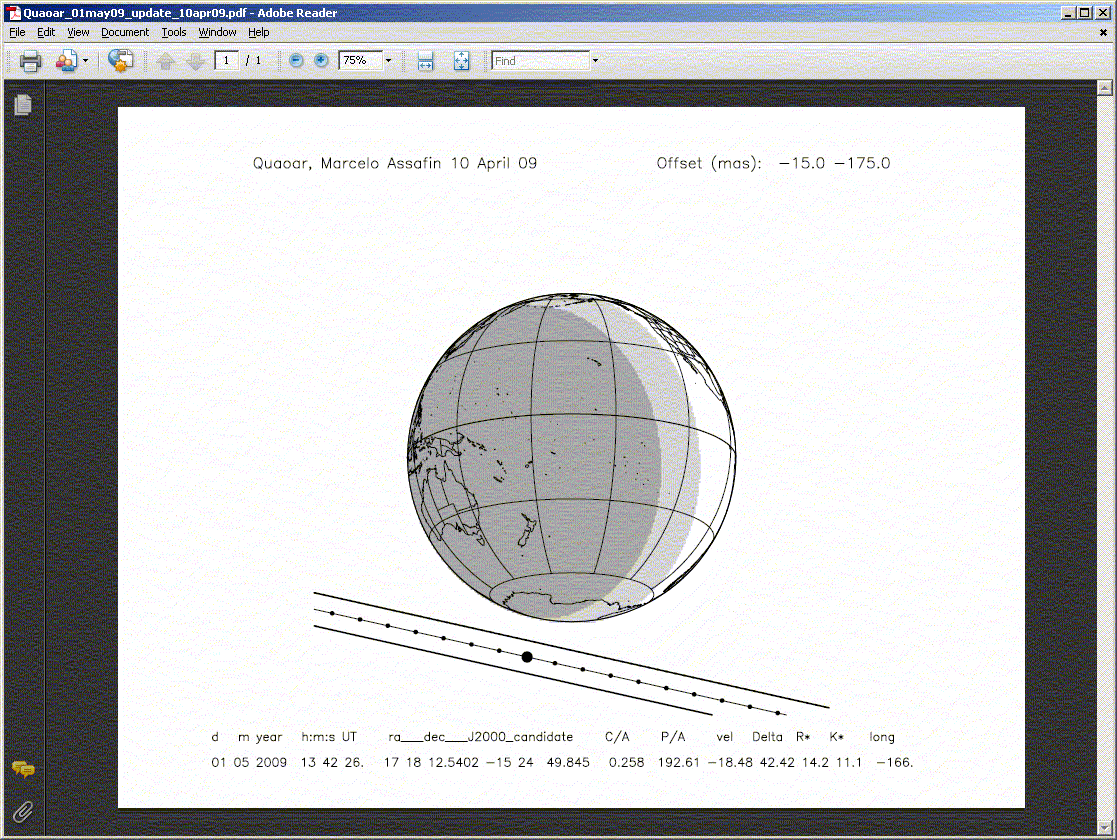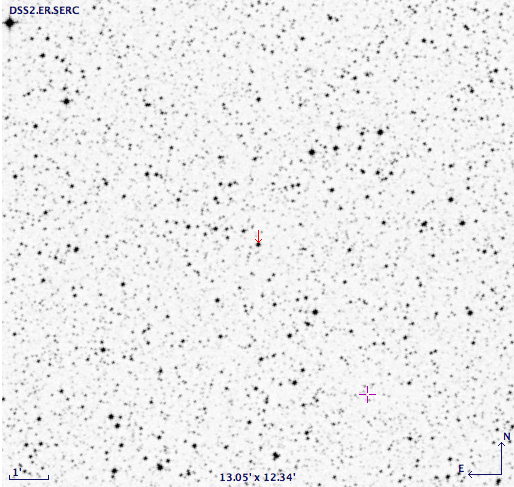From: Bruno Sicardy Sent: Friday, January 30, 2009 11:45 AM Subject: Occultations in Australia & New Zealand/2009
Dear colleagues,
We have been searching for stellar occultation by Pluto, its satellites (Charon, Nix & Hydra) and big Trans-Neptunians-Objects (TNO's) visible from AUS and NZ in 2009 (with some events involving *also* S. Africa and Namibia).
Some of them are reachable by amateurs. In order of decreasing priorities, I found:
NB. Pluto has V=14.3, R=13.8, and I=13.4, and will be ~2 arcsec north of Nix, ie two mag *fainter* than the star, hence not a problem.
Scientific returns are: (i) get Nix size to km accuracy, and thus derive albedo, from current brightness measurements. Albedo provides in turn constraints on surface composition, (ii) roughly estimate its density, as Nix mass is estimated from interactions with the other Pluto's satellites, see "Masses of Nix and Hydra", Tholen et al AJ 135, 777-784 (2008).
Uncertainty is still ~1000 km NS, so the event might go over NZ if shift is southward, and southern E and W AUS if shift is northward. Note that both NZ and AUS are in full night, and Nix will be high in the sky.
Thus, the track is well bracketted if shifts occur. This is actually the *best* opportunity encountered so far to get a Nix occultation, because of star brightness and density of professionals and amateurs potentially along the track and around it.
A caveat is the small size of Nix: diameter 100 km +/- 50 km, so a positive event should last at most for 5 sec, and therefore good time sampling is required. Also, the shadow track prediction will not be better than +/- 500 km beforehand, so that a given observer will have at most 10% of success, statistically.
Such configuration, however (brightish star and several amateur stations), is the only way to get a Nix event.
In conclusion, I think a CAMPAIGN SHOULD BE ORGANIZED in AUS and NZ for the Nix June 05, 2009 event (NB. this will be early morning of 6 June in Aus, NZ). Please CIRCULATE that information in amateur circles.
Nix 24 May 2009, 19:23 UT.
Nominal centrality on S. Australia (Sydney, Canberra, Siding Spring, Adelaide, Perth) and, low above horizon, South Africa and Namibia. NB NZ will be in morning twilight.
The star is fainter, though, with V=15.6, R=15.3, I=15.1, and Pluto will about 2 arsec south of Nix, one mag *brighter* than the star.
Thus this is a more difficult observation. However, as the event is "on/off", it may be attemptable. Also, it might be a good practice for the June 05 event.
Pluto 23 Aug 2009, 11:26 UT
It is nominally centered on Sydney, Canberra, Tasmania, but will also involve most Queensland and South Australia, and all New South Wales. NZ will be at the southern limit of the ~3000 km diameter shadow, and Perth at the northern limit of shadow.
Another good point: it is a slowish event (9.9 km/sec), so maximum duration can reach 4mn 30 sec.
BUT, the star is faint, with R=16.4. It is a very red star, however, K=11.7, so probably Imag (not known) will be good enough.
---> m-sized telescopes and larger should be involved.
Eris 14 November 2009, 15:25 UT.
Faint star (R~17, K=15.3, so maybe I is not so bad), but requiring *large* telescopes anyway.
Remember that Eris has a satellite that could also yield an event.
It will be full night in AUS and object will be high in the sky, NZ will be in morning twilight with object low above horizon.
2002TX300 09 Oct 2009, 10:28 UT.
Reasonably bright star (V=13.2, R=12.9), reachable by amateurs.
Nominal centrality over NZ, but low above horizon (eg 14.5 deg at Mt John). Could also involve Tasmania and W AUS coast, but with similar or even *lower* elevations.
Note that orbit is not SO WELL KNOWN as for Pluto, so that astrometric updates might end up with an event in N. Australia, Hawaii, central America, USA or even Canada.
2002TX300 29 Sept 2009, 12:34 UT.
Centrality would go over W. USA, northern Pacific and Philipins. As above, uncertainties are such that Hawaii, AUS and NZ might be involved, although lowish above horizon for the two latter countries.
BUT the star is faint, V=18, R~17.4, K=15.3, so *large* telescopes are required.
(7) Just FYI, as it is now **past**:
Quaoar, 27 Jan 2009, 20:45 UT.
Reasonable star R=13.8, I=13.9. Observations were attempted two days ago from Perth in morning twilight by James Biggs and Roger Groom, but were hampered by clouds or technical problems.
(8) Quaoar, 1 May 2009 (50000) Quaoar alert, May 1
From: Thomas Widemann & Bruno Sicardy, Paris-Meudon Observatory This alert follows a previous announcement by Bruno Sicardy sent to some of you on Feb. 1, 2009. (See below) Trans-Neptunian object (50000) Quaoar might occult a decently bright star, 2UCAC 26252549 J2000 17 18 12.5402 -15 24 49.845 R=14.3, J=12.0, K=11.2 May 1 2009,13:42:26 UT.

Star field for Quaoar 2009 May 01.

Dear all, We report an attempted observation of an occultation of UCAC star 26252549 by trans-Neptunian object Quaoar on May 1 2009. 15 observations were performed in 14 stations (see attached map), with telescope diameters ranging between 1 m and 25 cm. 3 were clouded out, 2 were lost to pointing/timing, 10 acquisitions were negative. A brief summary of observing reports is attached. The shadow was predicted to pass slightly outside the Earth, although given the uncertainties involved, it could have been potentially visible from Australia and New Zealand. Recently updated prediction was derived from a reanalysis of the star position by the Rio group of its 2008 observations, with an applied ephemeris offset for Quaoar of 0.015 arcsec in RA and -0.175 arcsec in DEC. A stellar occultation by Quaoar's satellite (distance of about 0.35 arcsec, with an estimated diameter of 100 km) or any additional orbiting material, was not reported. We would like to take advantage of this report to invite all observers involved to acquire post-event images of Quaoar along with nearby UCAC stars and send them to our group, to improve offset determination for future event predictions. We thank you again for your help and response, please note that a very promising event involving Pluto's satellite Nix and a bright star will occur within range of the same stations on June 6, 2009 around 16:40 UT (4:40am Australian Eastern Standard Time UT+10), see map Thomas Widemann Bruno Sicardy Paris-Meudon Observatory -- Thomas Widemann LESIA (Bat. 10) Observatoire de Meudon 5, place Jules Janssen 92190 Meudon, France
Cheers,
Bruno Sicardy
---